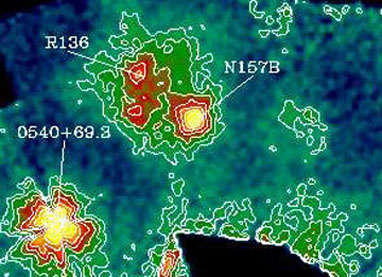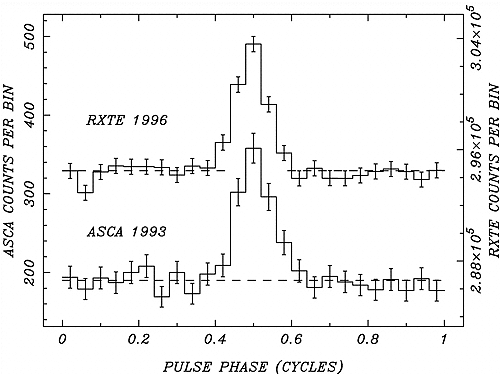
ASCA Image Credit: Wang and Gotthelf ApJ, 494, 623, 1998 While searching for a pulsar in the remnant of Supernova 1987A, Frank Marshall and collaborators serendipitously discovered an isolated pulsar in the nearby supernova remnant N157B in the 30 Doradus region of the Large Magellanic Cloud. The 16 ms pulsar has the fastest measured spin period of any pulsar associated with a SNR. N157B now joins the three other confirmed members of this class of "Crab-like" supernova remnants, having centrally filled morphologies, nonthermal X-ray spectra and central pulsars: the Crab Nebula, SNR B0540-693 in the Large Magellanic Could, and the nebula surrounding PSR B1509-58. The two RXTE observations, which occurred on 1996 October 12 and 1996 December 20, were compared with archival ASCA observations from 1993 once a pulse period was found, in order to confirm the detection of a pulsar, as well as to measure its spin-down rate and localize its position. The values derived for the period derivatives during the ASCA and RXTE observation epochs, and their slight differences, indicate that one or more glitches occurred during the interval. The values of P_dot are 5.154 (0.002) e-14 s/s and 5.174 (0.002) e-14 s/s for the ASCA and RXTE epochs respectively. In addition to a spin rate twice as fast as the Crab pulsar, the newly discovered pulsar, PSR J0537-6910 distinguishes iteself from the other young rotation-powered pulsars in SNRs by its narrow pulse profile, and its relatively large spindown age of 5000 years. This important new addition to the class of rotation-powered pulsars helps constrain models of neatron star spin rates at birth. Further observations will better constrain the age of the pulsar, measure a second derivative of the period and verify the existence of glitches. Figure: Pulse profiles of the newly discovered rotation powered pulsar in N157B from RXTE observations (above) and ASCA observations (below), indicating a largely unchanged narrow, single-peaked pulse profile.
Back to Greatest Hits of RXTE If you have a question about RXTE, please send email to one of our help desks.
|



